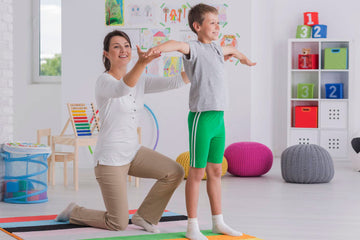If your child is complaining of foot pain, you want to help them feel better, but you may be at a loss for how to move forward. The good news is that a great deal of foot pain can be improved through simple stretching and strengthening exercises. Older children may be able to do these on their own, while younger children may need assistance to properly stretch.
Understand the More Common Causes of Foot Pain
One of the more common causes of foot pain is Planar Fasciitis. This condition results when the planar fascia, a thin ligament which connects the heel to the front of the foot, becomes irritated or inflamed. This is a common conditions for runners, athletes, and those who struggle with flexibility in their lower legs.
For most people with pain in their feet, strengthening and stretching the calf muscles and the fascia itself can help relieve pain so activity can be restored. Try out these exercises to reduce your, or your child’s, discomfort.
Wall Stretch For Calves
- Stand arm’s distance from the wall.
- Step your right foot towards the wall.
- Slowly and gently bend your right leg forward. Keep your left knee straight and your left heel on the floor.
- Hold the stretch for up to 30 seconds, then release. Repeat 3 times.
- Repeat on the other side.
Seated Stretches For Planar Fascia
- From a seated position, roll your foot over a frozen water bottle, foam roller, or cold can. Do this for one minute, then switch to the other foot and repeat.
- Cross one leg over the other. Grab your big toe on your crossed leg and gently pull it towards you. Hold the stretch for up to 30 seconds, then release. Repeat 3 times, then switch sides.
Use Stairs To Your Advantage
- Heel raises can be done on any set of stairs.
- Place one foot on the edge of the step, and hold onto the railing for support. Stretch your left heel down for 30 seconds, then press up onto your toes for 10 seconds. Repeat 3 times, then switch sides.
Pick Up Pebbles
- Sit in a chair with a cup in front of you, close to your feet. Scatter between ten and fifteen marbles or pebbles around the front of your chair.
- Use your toes to pick up a pebble and drop it in the cup. Make sure you do this with both feet, even if only one hurts.
Prevent Planar Fasciitis In the Future
Once your child’s heel and foot pain is relieved, your next goal is to prevent it from becoming uncomfortable again. Remember that your child should continue to stretch these areas, even if they’re not in pain, but can also:
- Choose comfortable shoe inserts for their athletic shoes that will properly cup the heel and support the arch; this will help support the fascia and keep it from tightening again.
- Choose shoes which have wide, supportive heel bases that absorb shock
- Have adequate cushioning in the front part of the foot bed.
If your child has been diagnosed with planar fasciitis or is experiencing foot pain that you can’t quite figure out, your first step may be their pediatrician, to make sure nothing more serious is happening. Once you know what is happening, consider contacting us to find the right insoles for your child, to help them regain their previous level of physical activity.





